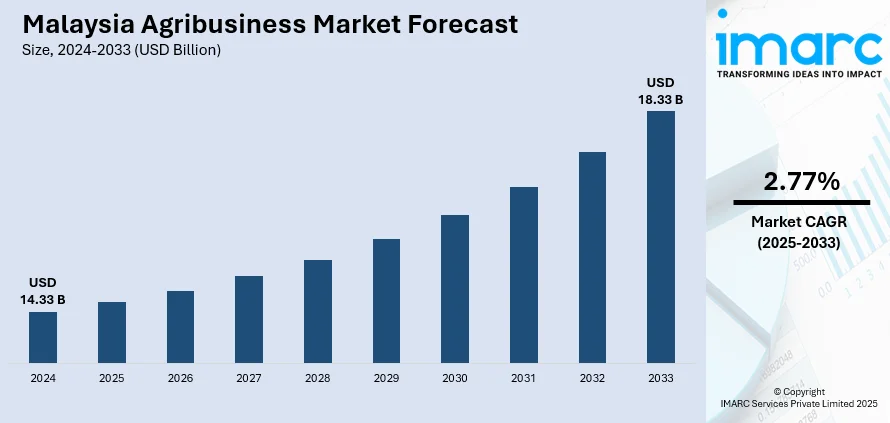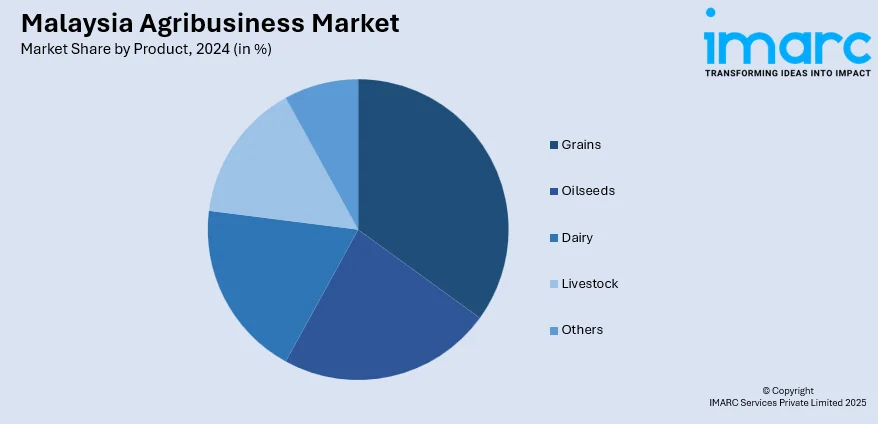
Malaysia Agribusiness Market Size, Share, Trends and Forecast by Product and Region, 2025-2033
Malaysia Agribusiness Market Overview:
The Malaysia agribusiness market size reached USD 14.33 Billion in 2024. The market is projected to reach USD 18.33 Billion by 2033, exhibiting a growth rate (CAGR) of 2.77% during 2025-2033. Government initiatives to strengthen food security, support mechanization, and enhance irrigation systems are enabling the agribusiness sector to meet domestic needs while expanding export opportunities. Besides this, rising adoption of artificial intelligence (AI), which is enabling predictive analytics, smart monitoring, and automated decision-making, is contributing to the expansion of the Malaysia agribusiness market share.
|
Report Attribute
|
Key Statistics
|
|---|---|
|
Base Year
|
2024
|
|
Forecast Years
|
2025-2033
|
|
Historical Years
|
2019-2024
|
| Market Size in 2024 | USD 14.33 Billion |
| Market Forecast in 2033 | USD 18.33 Billion |
| Market Growth Rate 2025-2033 | 2.77% |
Malaysia Agribusiness Market Trends:
Increasing food demand
Rising food demand is a key driver of the market, as the country’s growing population and rising incomes are fueling higher consumption of diverse food products, including rice, fruits, vegetables, poultry, seafood, and processed goods. This increasing demand is encouraging farmers and agribusiness companies to expand production capacity, adopt modern farming techniques, and invest in high-yield crop varieties to ensure consistent supply. The hospitality, retail, and export sectors are further amplifying this trend, creating steady need for both fresh and packaged products. Government initiatives to strengthen food security, support mechanization, and enhance irrigation systems are enabling the sector to meet domestic needs while expanding export opportunities. Apart from this, rising emphasis on pest control management is ensuring healthier crops and reducing yield losses. In December 2024, Terra Drone Agri launched an advanced pest management program over 3,548.46 hectares of oil palm farms in Malaysia. The initiative, started through the company’s Terra Agri service, targeted the fight against bagworm outbreaks, a major risk to plantation wellness and production. Moreover, the demand for value-added food items is leading to the growth of food processing industries, thereby increasing linkages between primary agriculture and manufacturing. Export-oriented agribusinesses are also benefiting from strong regional trade ties within the Association of Southeast Asian Nations (ASEAN).

To get more information on this market, Request Sample
Innovations in technology
Technological advancements are impelling the Malaysia agribusiness market growth. They aid in enhancing productivity, efficiency, and sustainability across the agricultural value chain. The adoption of modern farming equipment, automated irrigation systems, precision agriculture tools, and advanced post-harvest technologies is enabling farmers to optimize resource use, improve crop yields, and reduce operational costs. Innovations in seed technology, biotechnology, and climate-resilient crop varieties are helping mitigate the impact of unpredictable weather and pests, ensuring more stable food production. Digital platforms for supply chain management and market access are strengthening connectivity between farmers, distributors, and consumers, while cold chain improvements are preserving product quality for longer periods. Furthermore, advancements in food processing and packaging are increasing the competitiveness of Malaysian agribusiness products in domestic and export markets. Government support for technology adoption, alongside private sector investments, is accelerating the pace of modernization in both small-scale and commercial farming. Rising adoption of AI is enabling predictive analytics, smart monitoring, and automated decision-making, which is further boosting efficiency and driving innovations in Malaysia’s agribusiness sector. In September 2024, BoomGrow Productions Sdn Bhd and CelcomDigi Berhad revealed a strategic alliance aimed at transforming Malaysia's agricultural sector by integrating 5G connectivity, AI, and extended reality (XR) with precision farming solutions. Data from all BoomGrow Machine Farms across the country would be gathered into a unified dashboard for efficient oversight and management, facilitated by CelcomDigi's dependable and broad network coverage in Malaysia.
Malaysia Agribusiness Market Segmentation:
IMARC Group provides an analysis of the key trends in each segment of the market, along with forecasts at the country and regional levels for 2025-2033. Our report has categorized the market based on product.
Product Insights:

- Grains
- Wheat
- Rice
- Coarse Grains – Ragi
- Sorghum
- Millets
- Oilseeds
- Rapeseed
- Sunflower
- Soybean
- Sesamum
- Others
- Dairy
- Liquid Milk
- Milk Powder
- Ghee
- Butter
- Ice-cream
- Cheese
- Others
- Livestock
- Pork
- Poultry
- Beef
- Sheep Meat
- Others
The report has provided a detailed breakup and analysis of the market based on the product. This includes grains (wheat, rice, coarse grains – ragi, sorghum, and millets), oilseeds (rapeseed, sunflower, soybean, sesamum, and others), dairy (liquid milk, milk powder, ghee, butter, ice-cream, cheese, and others), livestock (pork, poultry, beef, and sheep meat), and others.
Regional Insights:
- Selangor
- W.P. Kuala Lumpur
- Johor
- Sarawak
- Others
The report has also provided a comprehensive analysis of all the major regional markets, which include Selangor, W.P. Kuala Lumpur, Johor, Sarawak, and others.
Competitive Landscape:
The market research report has also provided a comprehensive analysis of the competitive landscape. Competitive analysis such as market structure, key player positioning, top winning strategies, competitive dashboard, and company evaluation quadrant has been covered in the report. Also, detailed profiles of all major companies have been provided.
Malaysia Agribusiness Market News:
- In July 2025, BASF (Malaysia) Sdn. Bhd., in collaboration with the Malaysian Agricultural Research and Development Institute (MARDI), introduced two new Clearfield® rice varieties – MR CL3 and MR CL4. This launch signified an important achievement in agricultural innovation, highlighting both organizations' dedication to supporting Malaysian farmers with sustainable and resilient rice production technologies. Clearfield rice seeds represented a non-transgenic, non-genetically modified crop technology for rice cultivation created through conventional plant-breeding methods.
- In September 2024, Agri Malaysia 2024, the Malaysia International Agriculture Technology Exhibition, took place at the Setia City Convention Centre (SCCC) in Shah Alam, Selangor, drawing 13,000 agriculture experts. Operating under the theme ‘Empowering Agricultural Technology,’ Agri Malaysia 2024 functioned as a key B2B platform and showcased improvements in farming, cultivation, processing, and sustainable practices for farmers and growers in different sectors, such as agricultural commodities, fruits, vegetables, and horticulture.
Malaysia Agribusiness Market Report Coverage:
| Report Features | Details |
|---|---|
| Base Year of the Analysis | 2024 |
| Historical Period | 2019-2024 |
| Forecast Period | 2025-2033 |
| Units | Billion USD |
| Scope of the Report |
Exploration of Historical Trends and Market Outlook, Industry Catalysts and Challenges, Segment-Wise Historical and Future Market Assessment:
|
| Products Covered |
|
| Regions Covered | Selangor, W.P. Kuala Lumpur, Johor, Sarawak, Others |
| Customization Scope | 10% Free Customization |
| Post-Sale Analyst Support | 10-12 Weeks |
| Delivery Format | PDF and Excel through Email (We can also provide the editable version of the report in PPT/Word format on special request) |
Key Questions Answered in This Report:
- How has the Malaysia agribusiness market performed so far and how will it perform in the coming years?
- What is the breakup of the Malaysia agribusiness market on the basis of product?
- What is the breakup of the Malaysia agribusiness market on the basis of region?
- What are the various stages in the value chain of the Malaysia agribusiness market?
- What are the key driving factors and challenges in the Malaysia agribusiness market?
- What is the structure of the Malaysia agribusiness market and who are the key players?
- What is the degree of competition in the Malaysia agribusiness market?
Key Benefits for Stakeholders:
- IMARC’s industry report offers a comprehensive quantitative analysis of various market segments, historical and current market trends, market forecasts, and dynamics of the Malaysia agribusiness market from 2019-2033.
- The research report provides the latest information on the market drivers, challenges, and opportunities in the Malaysia agribusiness market.
- Porter's five forces analysis assist stakeholders in assessing the impact of new entrants, competitive rivalry, supplier power, buyer power, and the threat of substitution. It helps stakeholders to analyze the level of competition within the Malaysia agribusiness industry and its attractiveness.
- Competitive landscape allows stakeholders to understand their competitive environment and provides an insight into the current positions of key players in the market.
Need more help?
- Speak to our experienced analysts for insights on the current market scenarios.
- Include additional segments and countries to customize the report as per your requirement.
- Gain an unparalleled competitive advantage in your domain by understanding how to utilize the report and positively impacting your operations and revenue.
- For further assistance, please connect with our analysts.
 Request Customization
Request Customization
 Speak to an Analyst
Speak to an Analyst
 Request Brochure
Request Brochure
 Inquire Before Buying
Inquire Before Buying




.webp)




.webp)












